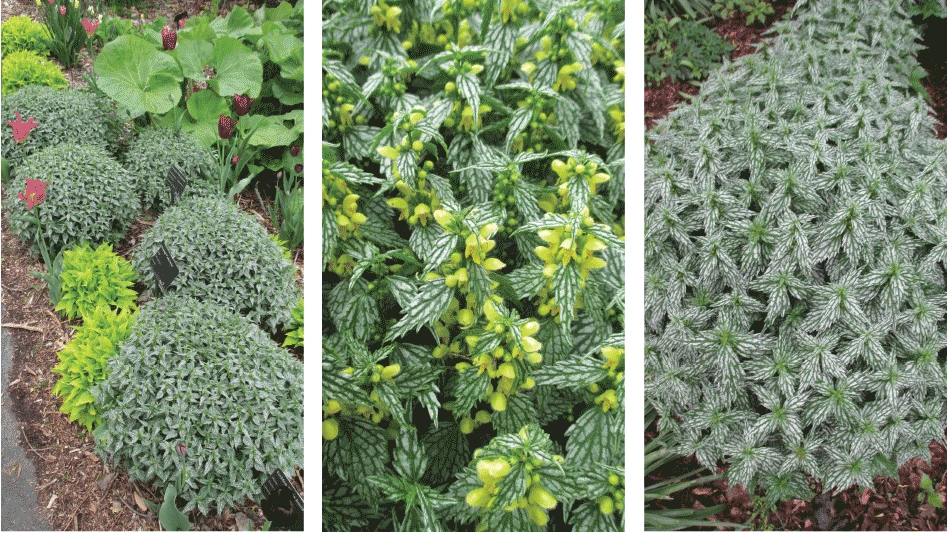
1. The diversity of sizes and shapes in nurseries makes spraying chemicals a challenge.
2. Cannon sprayer. 3. Air-blast sprayer. 4. Tower sprayer.
Despite even more stringent market requirements, applications of pesticides and other pest or disease control strategies have successfully ensured continuous production of high quality ornamental nursery crops. Since chemical pesticides were first developed 150 years ago, pesticide delivery systems have changed dramatically, from primitive hand-held paintbrush applicators to modern tractor-driven air-assisted sprayers and aircraft sprayers.
However, proficient applications of pesticide often are complicated by many factors. These include the use of a variety of equipment and methods, incompatible physical properties of different chemical sprays, diverse crops and their growth habits, numerous pests and diseases, disparity of operator skills, uncontrollable weather conditions, extensive worker safety, environmental regulations and fluctuating economics related to the benefits of pesticide applications.
Sprayer selection
Selection of a sprayer must take into account its capabilities and limits to effectively deliver the optimal amount of spray under specific conditions. However, current pesticide application guidelines for growing, protecting and marketing nursery crops are inadequate. This dilemma contributes to an increased use of pesticides and lowers spray application efficiencies in nursery crops. Consequently, excessive pesticides are often applied to target and non-target areas, resulting in greater production costs, worker exposure to unnecessary pesticide risks and adverse contamination of the environment.
Education is essential in any pest control strategy to have properly trained operators and to make the proper sprayer selection. Our research has demonstrated that growers could use their existing spray equipment to reduce pesticide and water use by 50 percent by properly changing spray nozzles at no extra cost and still achieve the effective pest and disease control. This is equates to doubling the pesticide application efficiency with reduced pesticide costs, reduced health risk to applicators and diminished adverse impact to the environment.
Air-blast sprayers
Air-blast sprayers are most commonly used to apply pesticides to plants with upright habits. They have adjustable nozzle angles and the capability to turn their nozzles on and off, providing a flexibility to accommodate the wide variety of tree shapes and heights found in many nurseries. Large nursery trees require large air-assisted sprayers with large fans to produce an adequate air volume for spray delivery to target areas.
Tower sprayers
Tower sprayers are also widely used in ornamental nurseries. Because spray clouds from tower sprayers can be directed horizontally or inclined toward the tree canopy, spray deposition and coverage on targets are less variable from tower sprayers than conventional air-blast sprayers. That capability also minimizes the amount of sprays that are carried above target canopies. Since the height of tower sprayers is fixed, tree tops taller than the sprayer are missed or inadequately sprayed.
Boom sprayers
In container crop production, boom sprayers, air-assisted boom sprayers and backpack sprayers are commonly used. For these sprayers, selection of nozzle type and size is critical and is dependent on crop characteristics, pest types and weather conditions. Horizontal boom sprayers are generally used for short container-grown woody plants.
They have two long spray booms that extend out both sides of the tractor. The total lengths of spray booms can range from several feet to over a hundred feet. These sprayers are modified conventional boom sprayers with air shrouds hung along the boom to direct small spray droplets into lower canopies and reduce spray drift.
Vertical boom sprayers are usually used for liners. They have drop nozzles, a pipe extension perpendicular to the boom, to discharge sprays closer to target areas. During the past decade, air-assisted boom sprayers were introduced for treating denser and taller crops because they have superior penetration capability and provided better coverage than conventional boom sprayers.
Backpack sprayers are preferred for spot treatments in small acreages or in hoop houses. Mount a constant flow rate valve upstream of the nozzle tip to prevent inconsistent sprays from pressure changes.
Cannon sprayers
Air-assisted cannon sprayers can cover wide spray swaths without the long booms used in conventional boom sprayers. Because of high airflow velocity, these sprayers can penetrate canopies and create turbulence that disturbs plants and increases spray deposition on upper and lower leaf surfaces. Compared with conventional boom sprayers and air-blast sprayers, cannon sprayers are small, easily transported and stored, and only require a small path for spray application. However, cannon sprayer performance is greatly influenced by wind conditions.
Tunnel sprayers
Tunnel sprayers were introduced for trees with small canopies during the past decade. They are either air-assisted sprayers or boom sprayers mounted with vertical booms. The fabric-covered frames of tunnel sprayers enclose the target tree and minimize spray drift. Sprays that are not deposited on the targets are recycled back to the spray tank. Disadvantages of tunnel sprayers are their large size, complicated structural configuration, frequent maintenance requirements and difficult transportation. Since the frames of the tunnel sprayer contact the trees, the sprayer can become contaminated with plant pathogens such as the fire blight bacteria and in turn can spread the bacteria to other trees.
Future sprayers
Safe, user-friendly and intelligent or semi-intelligent sprayers may answer the needs of nursery crops. The new advanced intelligent sprayers should deliver pesticides economically, accurately and requires minimum human inputs during the entire spray application process.
Hopefully, future sprayers will have an intelligence capability that will apply pesticide rates to match canopy size, shape and density. The intelligence system should be integrated with reliable sources where real-time analyses and accurate predictions can be obtained for population, movement and infestation of pest insects in a geographical area. This can lead to more effective timing of spray applications to prevent a buildup of pest populations. However, development of advanced sprayers will encounter a finite demand in the market, limited acreages in nursery crop production and growers’ uncertain, long-term financial plans.
Heping Zhu, is agricultural engineer, USDA/ARS Application Technology Research Unit, Wooster, Ohio; heping.Zhu@ars.usda.gov. Randy Zondag is extension horticulturist, Ohio State University Extension, Lake County, Ohio; zondag.1@osu.edu.
WANT MORE?
Enter your email to receive our newsletters.

Explore the April 2011 Issue
Check out more from this issue and find your next story to read.
Latest from Nursery Management
- These companies are utilizing plastic alternatives to reduce horticultural waste
- NewGen Boxwood added to Proven Winners ColorChoice line
- Terra Nova releases new echinacea variety, 'Fringe Festival'
- American Horticultural Society names winners of 2025 AHS Book Awards
- Nufarm announces unified brand
- American Horticultural Society announces winners of 2025 Great American Gardeners Awards
- Shifting the urban environment
- The Growth Industry Episode 3: Across the Pond with Neville Stein





